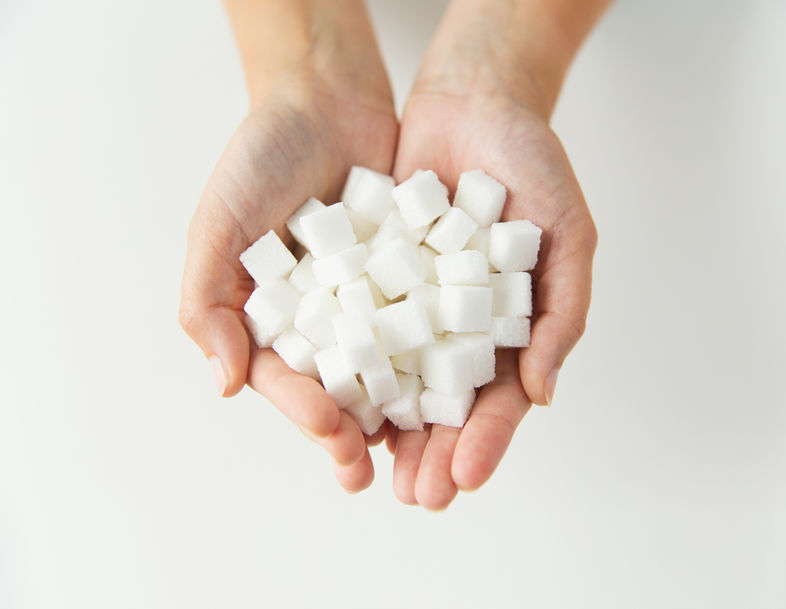×
7 Sugar Alternatives
- Danielle L’Ami

Did you know sugar might be more addictive than cocaine? Yes! When rats were given the opportunity to consume cocaine or sugar, they consistently chose the sugar (1). According to a Frontiers in Psychiatry study, sugar meets the DSM-5 test as an addictive substance. Many people try to eliminate sugar from their diet but find it almost impossible because sugar hides in so many of our foods especially in the processed foods. Even more frustrating, sugar is often disguised under unrecognizable names, many of which are chemically altered.
While most of us are familiar with the common names for sugar: sucrose, glucose, fructose, to name a few, there are several more. Virtahealth.com shares a larger list, 56 to be exact, of ways sugar can be slipped into your food under an unassuming name. The top seven are the most used.
But why do we want to pay attention to the amount of sugar we consume? Because according to addictioncenter.com, 75% of Americans consume too much sugar. Other studies have even shown that our addiction to sugar is on par with illegal drugs as mentioned earlier. But what does sugar do to our bodies? First, our bodies enjoy the dopamine release we receive when we eat a sugary treat (2). Then, we crave that release, perhaps just as much as we crave the sweet taste on our palates.
This craving has been linked to long-term health disabilities, from obesity to diabetes. It also can greatly affect our mental health. Those who are addicted may find themselves suffering from depression, anxiety, to high stress.
And much in the same way we indulge in caffeine to give our energy levels a boost, we often select sugary or processed foods when we think we are hungry or if our brain figures out a justification for the food. A great way to test if you are truly hungry or your brain is tricking you into thinking you are hungry is ask yourself if a steak sounds good right now. If the answer is yes, you are probably legitimately hungry and might want to go eat some non sugary, nutritious foods. If the answer is no, then go for a walk or drink some water to help you tame your sugar dragon. Eating less sugar can also be a great way to boost your attractiveness, read more here to find out how.
Here are seven sugar alternatives to help you lower your overall sugar consumption.
1. Honey
Healthline.com recognizes that while honey is primarily made up of fructose, it is a good step in starting your journey in reducing sugar. Because honey is sweeter than sugar and less refined, you may require less of the honey. However, you still want to be careful as fructose is processed by the liver. Raw honey is high in antioxidants, thanks to the phenolic acids and flavonoids found within, but don’t use that as an excuse to overindulge!
2. Maple Syrup
Maybe it’s the Canadian in me, but maple syrup is heaven to my palate. It is made from the sap of maple trees and is boiled down until it becomes a thick, very sweet liquid. As a little bonus, maple syrup does have a lower glycemic index (GI) compared to sugar, and therefore, it has a slower spike. Similar to honey, healthline.com states maple syrup may have trace minerals such as calcium, iron, zinc, potassium, and manganese, but you will still want to exercise caution if you are insulin resistant.
3. Stevia
I can still remember when stevia first came out on the market, as it seemed too good to be true. Known to the scientific world as Stevia Rebaudiana, stevia is derived from the leaves of a South American shrub from either the stevioside or the rebaudioside compound (3).
Stevia is 350 times sweeter than sugar and does not appear to increase glucose and insulin levels which can be very helpful for diabetics or people trying to eliminate or reduce sugar in their life. For some people, stevia has a bitter after taste and maybe off putting to some.
4. Dates
I added dates to the list because I truly believe they are great for baking treats, in a very natural way. They can puree up easily and add natural sweetness to food. Medlife.com highlights their nutritional benefits, (there are a lot) from high levels of antioxidants to being a natural anti-inflammatory.
Other benefits are improving bowel movements, brain function, reducing the risk of developing types of cancer, and it helps to fight off diabetes. Dates are still a fruit which means they are high in fructose and have a high glycemic index and should be consumed carefully if you have elevated blood sugar levels.
5. Xylitol
If you prefer to stay closer to the sweetness of sugar, then this may be a desirable replacement for you. Xylitol is extracted from corn or birch wood and is known as sugar alcohol. It is even present in fruits and vegetables such as strawberries, raspberries, and cauliflower.
Healthline.com states that it has 40% fewer calories compared to sugar, and does not contain fructose. Diabetics will appreciate that it does not raise their blood sugar or insulin levels. Dog owners do need to be aware, however, because it is highly toxic to our furry friends.
6. Yacόn Syrup
The Yacόn plant is native to South America and produces dark syrup, similar to molasses. This syrup, thanks to its high content of fructooligosaccharides, (say that ten times fast) can aid in lowering our GI, body weight, and risk of colon cancer.
Interestingly, fructooligosaccharides are a unique type of sugar molecule that we cannot digest. Since we don’t digest it, we don’t consume the calories either, and therefore this syrup has one-third the number of calories sugar does. You may even find yourself feeling more satiated after consuming it, according to healthline.com.
7. Monk Fruit Sweetener
Foodinsight.org describes this gem as coming from an Asian fruit, known either as lo han guo or swingle fruit (siraitia grosvenorii). Originally used as a treatment for colds and digestive issues, it is now also used as a sugar alternative.
Even though monk fruit is 150-200 times sweeter than sugar, it still has zero calories, thanks to the mogrosides that give it its sweetness. The mogrosides also have anti-inflammatory properties and antioxidants. You can use it in recipes as a 1:1 replacement for sugar. What I like about this one is that you can purchase it in crystals that look exactly like sugar, giving you the illusion that you are having sugar without the glucose spike.
Desserts used to be a special treat that was eaten occasionally for special treats, but now we consume close to 17 teaspoons per day. Through AGEs, sugar ages us and our organs quickly (4). Any effort that can be made to decrease the amount of sugar in your diet will have untold dividends in your health and the quality of your health as you age. This is an important health tip that is critical to learn while we are younger, and is included in our post on health secrets I wish I knew when I was 20. Why not try one of the above sugar alternatives so you can continue to indulge here and there while protecting your health?
